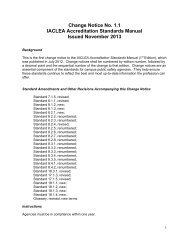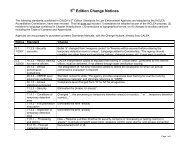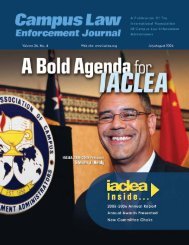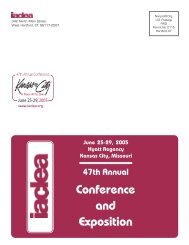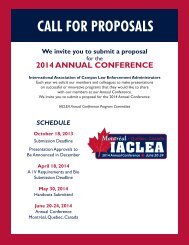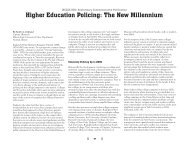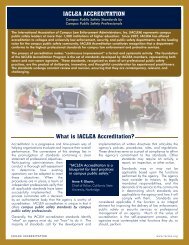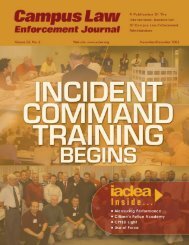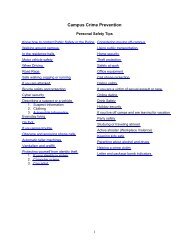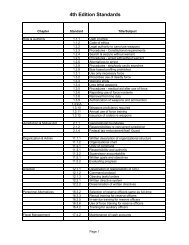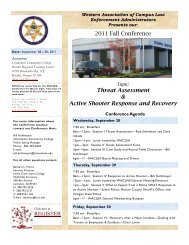Change Notice No. 1.1 IACLEA Accreditation Standards Manual ...
Change Notice No. 1.1 IACLEA Accreditation Standards Manual ...
Change Notice No. 1.1 IACLEA Accreditation Standards Manual ...
Create successful ePaper yourself
Turn your PDF publications into a flip-book with our unique Google optimized e-Paper software.
18 – Title IXIntroductionTitle IX of the Education Amendments of 1972 (Title IX), 20 U.S.C. §§ 1681 et seq., and itsimplementing regulations, 34 C.F.R. Part 106, prohibit discrimination on the basis of sex ineducation programs or activities operated by recipients of Federal financial assistance. The lawwas originally associated with gender equity in college sports programs, causing colleges anduniversities to ensure that men and women had equal opportunities for participation. However,sexual harassment of students, which includes acts of sexual violence, is a form of sexdiscrimination prohibited by Title IX. Sexual violence is a form of sexual harassment prohibitedby Title IX. As used in this chapter, “Title IX” refers to all forms of sexual harassment and sexualviolence.Title IX compliance is clearly an institutional responsibility. However, several areas of the lawhave clear implications for the institution’s police or security unit. The standards in this chapterrepresent the minimal requirements for agencies in contributing to the institution’s overall TitleIX responsibilities. It is strongly recommended that agency CEO’s work collaboratively with theinstitution’s Title IX coordinator so that the agency’s efforts are fully integrated with overarchinginstitutional policies.18.<strong>1.1</strong> Title IX ReportingA written directive describes the agency’s procedures for responding to and reporting sexualharassment complaints.Commentary: Agency personnel may be designated as Responsible Employees, i.e. “Title IXreporters” by the institution. If so, a directive should describe steps to be taken by firstresponders and supervisory personnel when responding to an incident involving a possible TitleIX violation. Important to note is that a person’s conduct may constitute unlawful sexualharassment under Title IX even if there is no evidence of a criminal violation. It is thereforeimportant that agency personnel do not dismiss or overlook behavior that violates Title IX byconcluding that a criminal offense did not occur. Even if a criminal violation has not occurred,the institution still has a duty under Title IX to resolve complaints promptly and equitably, even ifthe complainant does not request such resolution. The directive should emphasize the agency’srole as a Title IX reporter to the institution’s Title IX coordinator and should likewise ensure thatreports of sexual harassment are properly conveyed through appropriate institutional channels.The institution’s Title IX policies and procedures may be used to satisfy all or part of thisstandard.18.1.2 Title IX TrainingTitle IX training is conducted with all agency personnel biennially, as well as with newly hiredpersonnel. Training should consist of the following:a. How to identify sexual harassmentb. The institution’s Title IX reporting and grievance proceduresc. Any other procedures used by the institution to investigate reports of sexual violence.Commentary: <strong>No</strong>ne.9



